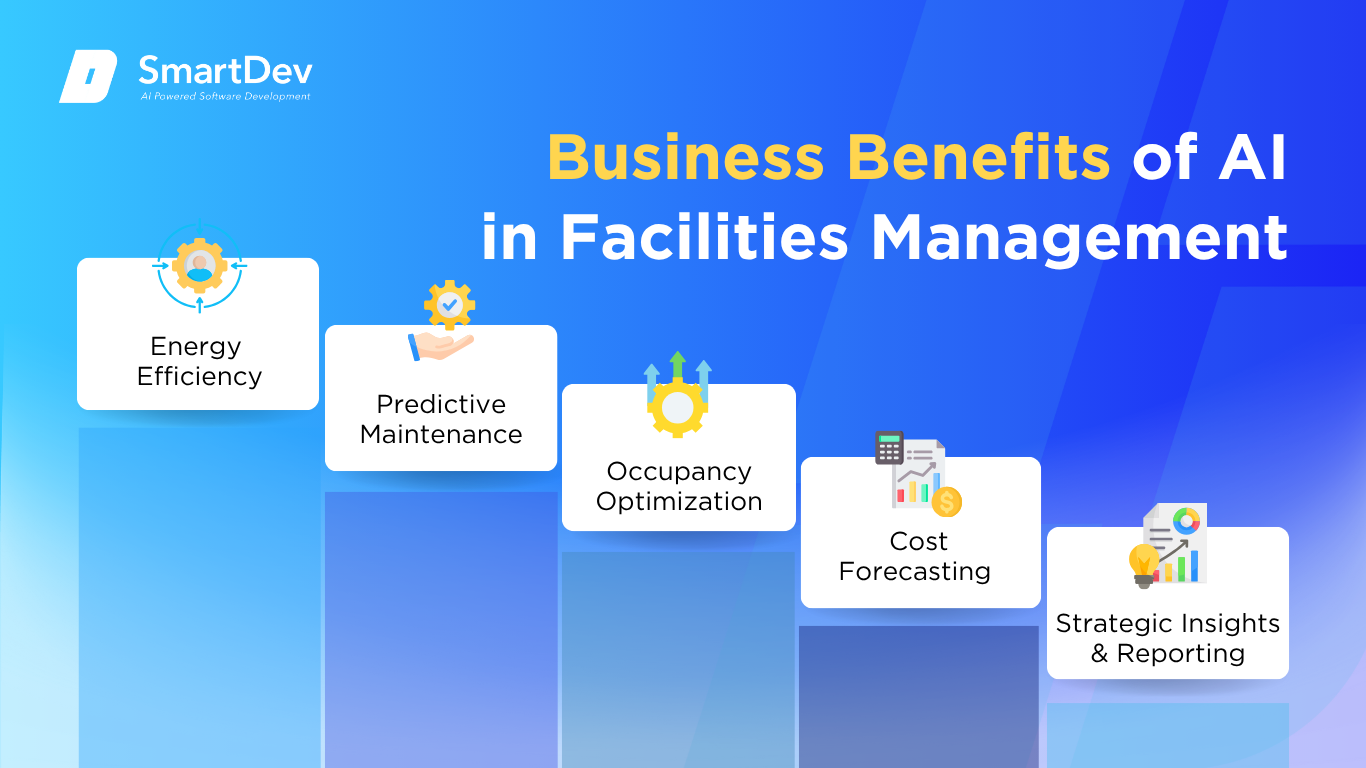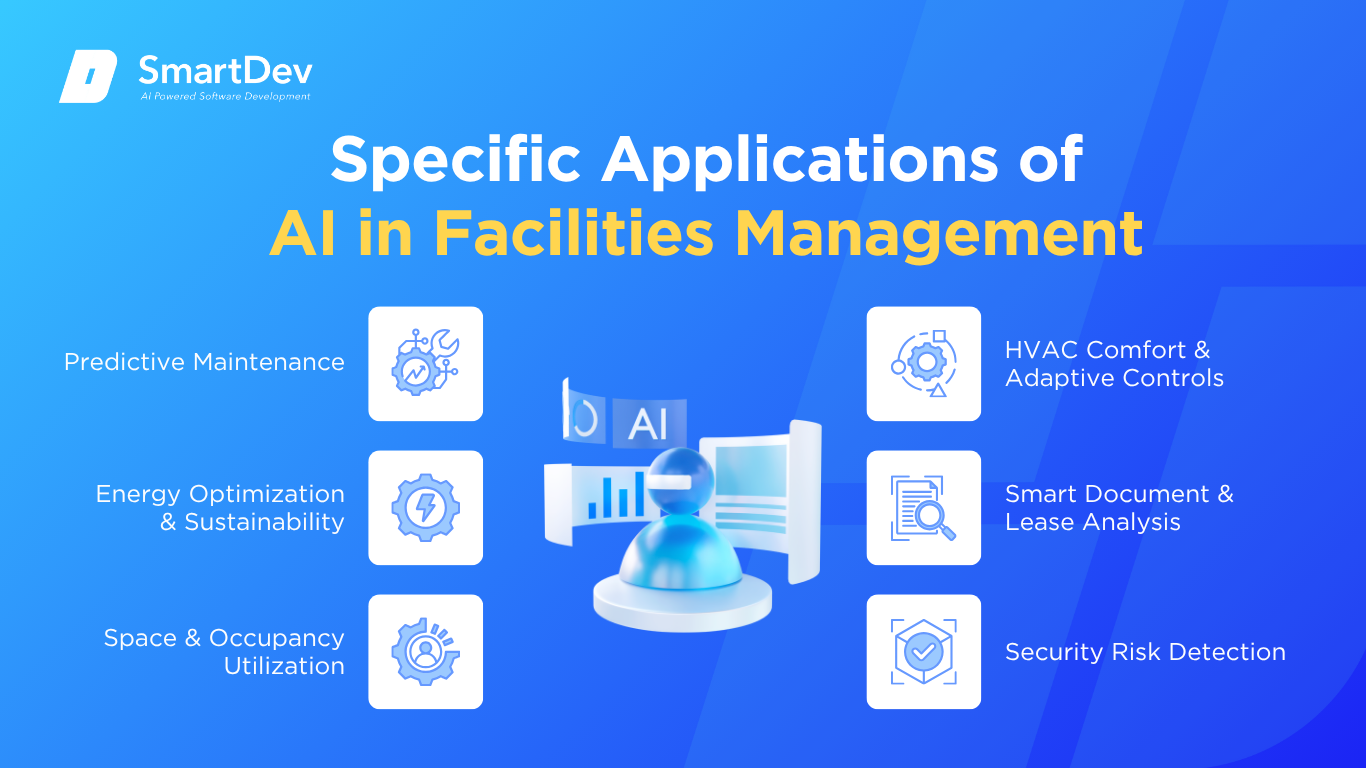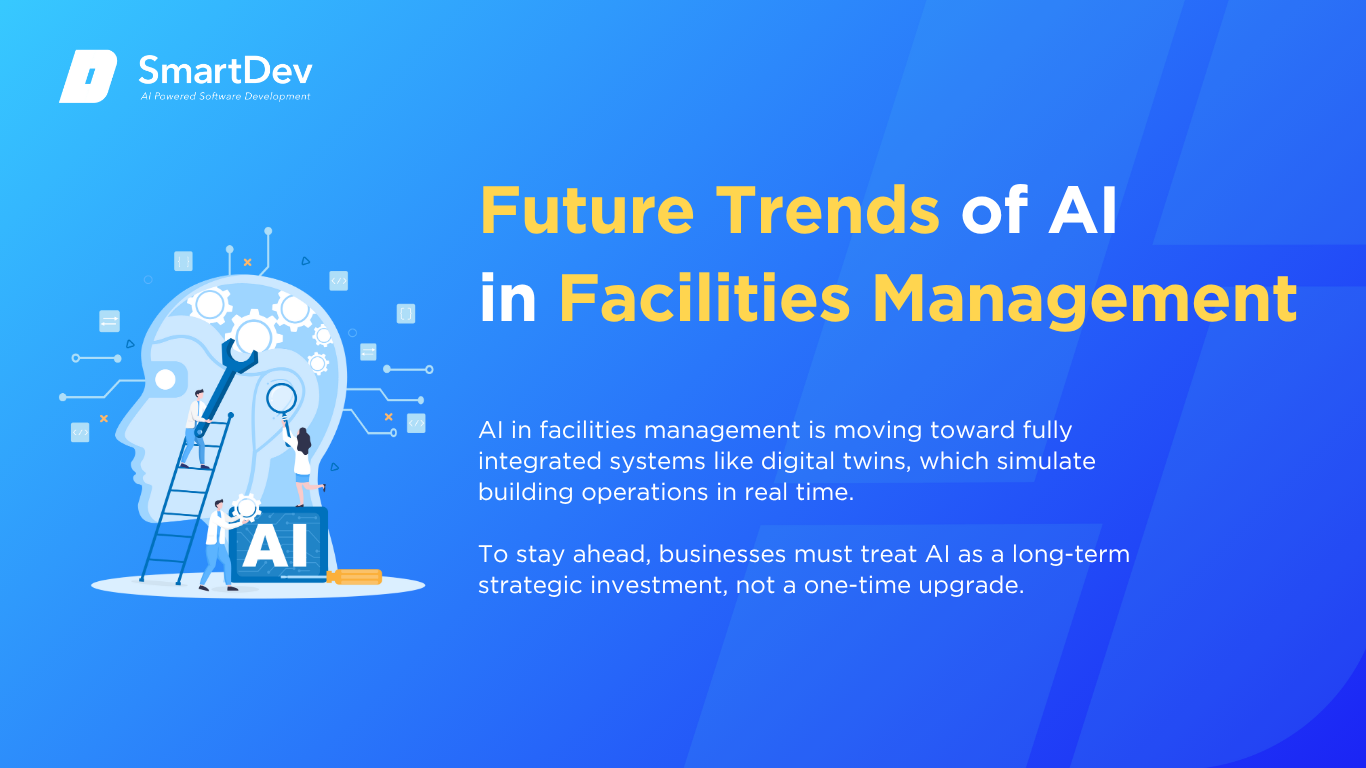Introduction
Facilities management faces pressing challenges: soaring energy costs, fragmented maintenance processes, and growing demands for sustainability and occupant comfort. Artificial Intelligence (AI) offers a transformative solution: automating routine tasks, optimizing energy use, and enabling predictive insights. This guide explores how AI is reshaping modern facilities management, delivering real‑world results and guiding implementation strategies.
What is AI and Why Does It Matter in Facilities Management?

Definition of AI and Its Core Technologies
Artificial Intelligence (AI) refers to computer systems that perform tasks requiring human-like intelligence, such as learning and decision-making. It relies on technologies like machine learning, natural language processing, and computer vision to interpret data and act autonomously. These tools are particularly valuable in data-intensive fields like facilities management.
In facilities management, AI is used to automate maintenance, control building systems, and analyze real-time sensor data. It helps predict equipment failures, optimize energy use, and adjust environments based on occupancy. This allows facility teams to operate more efficiently while reducing costs and improving occupant comfort.
The Growing Role of AI in Transforming Facilities Management
AI is playing a growing role in shifting facilities management from reactive to proactive operations. It enables real-time monitoring and decision-making by processing data from sensors, equipment logs, and environmental systems. As a result, facility managers can anticipate issues and respond with greater precision and speed.
Predictive maintenance is one of the most impactful applications. AI analyzes usage patterns and historical performance to forecast when equipment is likely to fail. This approach reduces unplanned downtime and extends the life of critical assets.
Energy optimization is another key area where AI is making a difference. Smart systems adjust lighting, HVAC, and other controls based on occupancy patterns and weather forecasts. These adjustments help reduce energy costs while maintaining comfort and operational efficiency.
Key Statistics and Trends Highlighting AI Adoption in Facilities Management
AI adoption in facilities management is still emerging, with only 10.4% of organizations currently using AI and 59.1% without a formal strategy, according to JLL’s 2024 report. However, 84% of industry leaders plan to increase AI use, focusing on energy efficiency and predictive maintenance.
A Honeywell survey shows 55% of users apply AI to manage building energy, 60% use it for predictive maintenance, and 40% for comfort and water control. Still, 90% of managers face hiring challenges due to the need for more tech-skilled staff.
Across industries, 78% of organizations use AI in at least one function and 71% have adopted generative AI, yet only 26% are seeing scalable value, according to McKinsey and BCG reports. Facilities teams must bridge this gap to fully realize AI’s potential.
Business Benefits of AI in Facilities Management
AI is delivering measurable value in key areas of facilities management, from reducing costs to improving building performance. By targeting long-standing operational challenges, it enables facility teams to work smarter, faster, and more strategically.

1. Energy Efficiency
AI reduces energy use by adjusting HVAC, lighting, and other systems based on real-time inputs like occupancy and weather. These optimizations run automatically, maintaining comfort while cutting energy waste. The result is lower utility costs and improved sustainability.
Buildings using AI-powered systems have achieved up to 15.8% energy savings and significant emissions cuts. Automation ensures consistent performance without relying on manual controls. This drives long-term savings and supports compliance with environmental targets.
2. Predictive Maintenance
AI identifies equipment issues before they happen by analyzing sensor and performance data. This enables timely, scheduled maintenance and avoids costly emergency repairs. System reliability improves while unplanned downtime drops.
Facilities using predictive tools reduce service disruptions and extend asset life. Teams shift from reactive to proactive maintenance, improving efficiency. This leads to fewer interruptions and better resource use.
3. Occupancy Optimization
AI tracks how space is used through sensors and digital activity. This helps managers reassign underused areas, improve layouts, and support flexible work. Real-time usage data also guides cleaning and lighting schedules.
Better space use lowers operating costs and improves occupant satisfaction. AI enables smarter decisions about space planning and redesign. Over time, it helps reduce overhead and improve workplace experience.
4. Cost Forecasting
AI analyzes trends in maintenance and operations to predict future costs. These forecasts support more accurate budgets and capital planning. Real-time insights show where spending is inefficient.
With better data, teams avoid surprise expenses and focus resources strategically. AI helps justify investment in upgrades or preventive work. This results in tighter financial control and long-term savings.
For more on how AI can streamline cost forecasting and budgeting, check out our article on AI-powered financial modeling for smarter insights and quicker decisions.
5. Strategic Insights and Reporting
Generative AI creates reports, summarizes leases, and analyzes trends across portfolios. It automates routine analysis, freeing staff to focus on decisions. Facilities teams gain faster access to actionable insights.
For instance, AI may highlight rising maintenance costs or suggest more favorable lease terms. These tools enhance visibility and help prioritize improvements. They also position facilities as a key contributor to strategic planning.
To learn how AI can integrate with cloud infrastructure for enhanced flexibility, check out our case study on Scaling Boldr with AWS: A Secure and Flexible Infrastructure.
Challenges Facing AI Adoption in Facilities Management
Despite its potential, AI adoption in facilities management faces several practical barriers. These challenges must be addressed early to unlock AI’s full impact and ensure long-term success.

1. Data Fragmentation
Facilities data often exists across disconnected platforms – maintenance logs, energy meters, and building systems are rarely integrated. This fragmentation prevents AI from accessing the full context needed for accurate analysis. As a result, insights may be incomplete or unreliable.
Combining these data sources requires significant effort in system integration and data normalization. Without a unified platform, AI tools can’t scale effectively. This limits their value and slows adoption across multiple facilities.
To learn how unstructured data can be effectively leveraged in AI applications, check out our detailed guide on how AI unlocks the power of unstructured data.
2. High Implementation Costs
Adopting AI typically requires investments in sensors, infrastructure upgrades, and software integration. These costs can be prohibitive, especially for smaller or older buildings. Return on investment may take time to materialize.
Legacy systems often lack compatibility with AI platforms, increasing deployment complexity. Facilities teams may also need to hire consultants or IT support. These added layers slow down implementation and increase upfront risk.
3. Data Quality Issues
AI depends on clean, accurate, and continuous data to function properly. In many facilities, data is missing, outdated, or inconsistent, especially for older assets without digital tracking. This lowers prediction accuracy and reduces trust in AI outputs.
Improving data quality requires standardization, monitoring, and sometimes re-instrumenting equipment. These steps can be time-consuming and expensive. Until data integrity improves, AI performance remains limited.
4. Privacy and Security Concerns
AI systems often use data from occupancy sensors, access badges, or Wi-Fi networks, which can raise privacy concerns. If data is not anonymized or securely stored, organizations face regulatory and ethical risks. Poor handling of personal data can lead to legal exposure or reputational damage.
Robust cybersecurity and clear data governance are essential. Organizations must ensure that AI tools comply with privacy laws like GDPR. These requirements can slow deployment and increase the need for legal oversight.
To understand the potential privacy risks and the best practices for securing AI systems, our detailed guide on AI and data privacy provides valuable insights.
5. Skills and Change Management
Many facilities teams lack in-house expertise to manage or interpret AI tools. Without proper training, staff may misuse or ignore AI-generated insights. Resistance can also come from fear of job displacement or unfamiliar technology.
Successful adoption depends on leadership support and clear role definitions. Upskilling or hiring new talent is often necessary. Without this foundation, even the best AI systems may fail to deliver value.
Specific Applications of AI in Facilities Management

1. Predictive Maintenance
Predictive maintenance tackles the high cost of unplanned equipment failures in facility management. By using AI to anticipate when a system is likely to fail, organizations can shift from reactive to proactive maintenance. This prevents service disruptions, reduces repair costs, and extends equipment lifespan.
These systems use data from IoT sensors measuring vibration, temperature, runtime, and more. Machine learning models detect anomalies and predict potential failures before they cause breakdowns. This data is processed within platforms like CMMS (Computerized Maintenance Management Systems) to automate maintenance scheduling.
The benefits include reduced operational downtime, optimized workforce allocation, and improved asset health monitoring. However, the success depends on data quality, the scalability of models, and resistance to false alarms. Bias in the models or incorrect thresholds can lead to unnecessary interventions or overlooked issues.
Real-world example:
Siemens used MindSphere, a cloud-based IoT OS, to monitor building assets and detect anomalies in HVAC and lighting systems. This reduced reactive maintenance by 25% and extended equipment life.
2. Energy Optimization and Sustainability
AI energy management addresses the challenge of reducing electricity costs and meeting sustainability targets. Facilities often waste energy due to outdated controls and inefficient scheduling. AI enables real-time optimization based on dynamic factors like occupancy, weather, and grid rates.
Advanced systems use reinforcement learning to analyze historical usage patterns and forecast future demand. These algorithms then adjust HVAC and lighting setpoints to align energy usage with need. The systems learn over time and adapt to changing operational and environmental conditions.
The outcome is significant cost savings and reduced carbon emissions, helping facilities meet ESG benchmarks. These systems also improve tenant comfort by maintaining stable internal environments. However, AI must be transparent and auditable to avoid over-optimization and unintended consequences.
Real-world example:
BrainBox AI cut energy use by 15.8% at 45 Broadway, NYC, saving $42,000 yearly and reducing CO₂ emissions by 37 metric tons.
Explore how integrating AI and APIs can optimize energy usage and reduce operational costs in our detailed guide on Banking as a Service (BaaS).
3. Space & Occupancy Utilization
Space underuse and inefficiencies are major cost drivers in facilities management. AI-based space analytics help monitor, measure, and improve the use of office, campus, or warehouse space. This enables better allocation, downsizing, or redesigns to improve ROI on real estate.
AI systems aggregate data from sources such as badge swipes, Wi-Fi logs, and infrared sensors to assess how spaces are used. Machine learning algorithms analyze this data to forecast demand patterns and suggest layout optimizations. These systems are typically part of IWMS platforms and are key for hybrid workplace planning.
Strategically, AI supports smarter leasing decisions, enhanced collaboration, and facilities right-sizing. It improves space planning agility and helps organizations meet changing workforce needs. Privacy concerns must be addressed when collecting occupant location and behavior data.
Real-world example:
Lincoln University in New Zealand used Aware AI sensors to assess classroom and office usage, which improved cleaning schedules and space allocation, cutting costs and boosting efficiency.
4. HVAC Comfort & Adaptive Controls
Maintaining thermal comfort while managing energy efficiency is a major challenge for facility managers. AI-enabled HVAC systems use occupant feedback and environmental data to continuously adapt temperature control strategies. This allows organizations to meet energy savings goals without compromising comfort.
These adaptive systems use reinforcement learning and human-in-the-loop (HITL) models to adjust thermostat settings dynamically. Occupants may input preferences via apps, while the AI also considers electricity pricing and usage forecasts. The model balances trade-offs in real-time to minimize energy while maintaining satisfaction.
Organizations benefit from lower electricity costs, increased occupant satisfaction, and compliance with building standards. These systems also support demand-response programs by adjusting usage during peak pricing events. Challenges include achieving consistent feedback input and ensuring privacy of user data.
Real-world example:
Researchers at the University of Waterloo showed HITL AI could save up to 40% on HVAC energy without sacrificing comfort using dynamic scheduling and user feedback.
5. Smart Document & Lease Analysis
Managing contracts, leases, and facility documentation is labor-intensive and prone to oversight. Generative AI tools help parse complex legal and operational documents to extract critical terms and deadlines. This improves compliance, reduces risk, and saves administrative time.
These tools use large language models (LLMs) to understand document structure and semantics. They flag anomalies, highlight important clauses, and summarize obligations using natural language outputs. Integration with IWMS or ERP systems ensures that AI insights can trigger workflows and alerts.
Organizations gain from increased transparency and faster response to lease or vendor obligations. This also enhances negotiation leverage by uncovering historical patterns or missed escalations. Ethical use requires safeguarding confidential and contractual data within AI environments.
Real-world example:
CBRE’s Ellis AI lets staff extract lease terms and clauses via natural language queries, boosting compliance and speeding up document reviews across its global portfolio.
6. Security Risk Detection
Security remains a critical priority for facilities, especially in high-traffic or sensitive locations. AI-based surveillance systems analyze live video feeds and access logs to detect unusual behavior or unauthorized entries. This enhances situational awareness and accelerates incident response.
Computer vision models track motion, facial patterns, and access credentials to identify risks. Integrated with facility access systems and alarms, AI provides real-time alerts to security staff or control centers. The models improve over time by learning from past incidents and false alarms.
Benefits include reduced theft, vandalism, and workplace incidents, along with enhanced staff safety. Ethical concerns center on data privacy, surveillance transparency, and consent for video monitoring. Organizations must balance effectiveness with compliance to privacy regulations like GDPR.
Real-world example:
JLL integrated AI video analytics into client sites to detect security breaches, combining camera feeds with access logs for real-time alerts and faster response.
If you’re looking to enhance security in your facility management systems, our article on AI-driven fraud detection shows how AI can help identify and prevent suspicious activities.
Need Expert Help Turning Ideas Into Scalable Products?
Partner with SmartDev to accelerate your software development journey — from MVPs to enterprise systems.
Book a free consultation with our tech experts today.
Let’s Build TogetherExamples of AI in Facilities Management
AI is no longer theoretical in facilities management, it’s delivering measurable results. The following case studies highlight how industry leaders are applying AI to reduce costs, optimize operations, and drive sustainability.
Real-World Case Studies

1. BrainBox AI at 45 Broadway: Autonomous HVAC Optimization
At 45 Broadway, a 32-story commercial building in New York, BrainBox AI integrated its autonomous AI platform with the existing building management system to dynamically optimize HVAC operations. The system uses reinforcement learning and edge-AI to modulate airflows and setpoints based on live weather, occupancy, and usage data.
Over 11 months, this AI deployment cut HVAC energy usage by 15.8%, saving approximately $42,000 annually and reducing 37 metric tons of CO₂ emissions. These gains were achieved without disrupting tenant comfort or operations.
2. Google DeepMind: Data Center Cooling AI
Google applied DeepMind’s deep reinforcement learning to optimize energy usage for cooling in its data centers. The system processed data from thousands of sensors to predict future temperature and adjust cooling systems in real-time, improving precision and minimizing overcooling.
This project reduced the amount of energy used for cooling by 40%, resulting in about a 15% improvement in Power Usage Effectiveness (PUE). It stands as one of the most cited examples of AI improving sustainability and operational efficiency in high-scale infrastructure.
3. CBRE’s Ellis AI: Document Intelligence for Lease Management
CBRE launched Ellis AI, a natural language processing platform developed with Microsoft, to streamline the analysis of leases and property documents across its global portfolio. The system enables employees to query lease terms, obligations, and maintenance schedules using everyday language, extracting data in seconds instead of hours.
This tool has significantly increased compliance visibility and reduced manual document review time, with CBRE using it in over 500 million square feet of managed space. Ellis AI demonstrates how generative AI is automating legal and operational document review at scale.
Innovative AI Solutions
AI-powered digital twins are reshaping facilities management by creating live virtual replicas of buildings for monitoring, simulation, and predictive insights. Platforms like those used in commercial real estate track HVAC, lighting, and occupancy in real time, improving operational decisions and energy forecasts. These models reduce risk, cut costs, and enhance occupant comfort through real-time data integration.
Companies like Foxconn and SAS use NVIDIA’s Omniverse and advanced simulation platforms to model building layouts, airflow, and thermal dynamics. This allows them to test operational scenarios virtually, improving facility performance before implementing physical changes. These solutions represent the next frontier in proactive, AI-driven facility optimization.
AI-Driven Innovations Transforming Facilities Management
Emerging Technologies in AI for Facilities Management
AI technologies are redefining how facility managers handle daily operations by automating routine tasks and interpreting vast data streams. Generative AI helps convert maintenance logs, energy consumption data, and sensor feedback into clear, actionable insights. These systems enhance communication by allowing staff to interact with facility information using natural language, reducing the need for technical interpretation.
Computer vision is also playing a growing role in managing physical spaces through real-time monitoring and analysis. It detects changes in occupancy, identifies equipment issues, and monitors environmental conditions without constant human oversight. By turning visual and sensor data into smart decisions, facility teams can respond faster, improve safety, and reduce resource waste.
AI’s Role in Sustainability Efforts
Sustainability in facilities management is becoming more achievable as intelligent systems uncover patterns of inefficiency and energy waste. With predictive analytics, facility teams can spot when systems like HVAC or lighting consume more power than necessary. This enables proactive adjustments that lower utility costs and support environmental goals.
Smart building systems also adapt to usage trends by learning how and when spaces are used, fine-tuning operations throughout the day. They optimize energy use by directing resources only where needed and minimizing waste in underutilized areas. These data-driven insights lead to greener, more cost-effective facility operations.
How to Implement AI in Facilities Management
Implementing AI in facilities management isn’t just about adopting new tools, it’s about reshaping how your team works, plans, and responds. To get the most value, you need a thoughtful approach that builds readiness, aligns systems, and supports your people every step of the way.

Step 1: Assessing Readiness for AI Adoption
Before implementing AI, take a close look at where your operations currently stand. Start by identifying parts of your facilities workflow that rely heavily on manual checks, like maintenance scheduling, space monitoring, or equipment tracking. These repetitive tasks often yield the clearest benefits from AI and make excellent low-friction entry points.
It’s also essential to gauge how open your organization is to new technology. AI adoption isn’t just a technical upgrade, it’s a shift in mindset. Without buy-in from leadership and operations teams, even the best AI strategies can struggle to gain traction.
Step 2: Building a Strong Data Foundation
A successful AI strategy depends on a well-organized, consistent stream of data. Facilities teams need to collect and maintain reliable records from building systems, sensors, work orders, and energy consumption. The better your data, the smarter and more accurate your AI outcomes will be.
Centralizing data across departments ensures everyone is working from the same baseline. Good data governance – clear standards for how data is gathered, stored, and used – is critical for maintaining accuracy and security. Once your data is clean and connected, your AI tools can deliver real business impact.
Step 3: Choosing the Right Tools and Vendors
Choosing AI solutions is more than a technical decision, it’s about finding a partner who understands your operational goals. Look for vendors with a strong track record in facilities or building systems and make sure their tools can integrate with what you already use. The ideal platform should enhance what you’re doing, not require a full overhaul.
Transparency is just as important as features. Be clear about how your data is being used, stored, and protected. Trustworthy vendors should offer full support, regular updates, and terms that align with your organization’s needs over time.
Step 4: Pilot Testing and Scaling Up
Start small to prove AI’s value before scaling up. Run a pilot on one building system – like HVAC performance or maintenance alerts – to test how the technology works in real-world conditions. Early results will show what’s working and where improvements are needed.
Use feedback from the pilot to adjust your approach. Measure what matters, document what you learn, and involve your team in shaping the rollout. Once you’ve got clear wins, it’s much easier to build the case for expansion across your entire portfolio.
Step 5: Training Teams for Successful Implementation
Your people are the key to AI success. Train staff on how to use AI tools effectively, showing them how technology can simplify their work, not replace it. When teams understand the value, adoption becomes far more natural.
Encourage open collaboration between facility managers, IT, and operations teams. AI works best when human expertise complements data-driven insights. A well-prepared workforce ensures the technology is used consistently and confidently every day.
To ensure successful AI integration, institutions should start with a clear roadmap. Our guide for tech leads outlines how to assess readiness and align stakeholders from the start.
Measuring the ROI of AI in Facilities Management
Key Metrics to Track Success
To evaluate the return on AI investments, focus on metrics that directly tie into operational efficiency and financial outcomes. Reduced energy consumption, fewer equipment failures, and improved maintenance scheduling are some of the first indicators that AI is driving performance. Monitoring shifts in utility usage or asset uptime can provide concrete, early signals of improvement.
Over time, cost reductions become more apparent. Track savings from lower repair expenses, reduced emergency interventions, and improved workforce productivity. It’s also important to consider softer metrics like improved occupant satisfaction and reduced carbon emissions, which contribute to long-term value and regulatory compliance.
Case Studies Demonstrating ROI
At a Manhattan office building, BrainBox AI’s autonomous HVAC system reduced energy use by 15.8%, saving over $42,000 annually and cutting 37 metric tons of CO₂ emissions in just one year. This retrofit showed how AI can quickly deliver measurable financial and environmental impact with minimal disruption.
In industrial settings, predictive maintenance has cut downtime by 35% and slashed costs by 25%, delivering six-figure savings per facility. One automotive plant saved over $1 million through early fault detection on critical machinery – proof that AI-driven monitoring directly protects both assets and the bottom line.
Common Pitfalls and How to Avoid Them
Misaligned goals and vague metrics often undermine AI ROI. Without clear KPIs, projects lack direction and impact. Defining success from the start ensures AI aligns with business value.
Poor data quality and fragmented systems also stall results. AI needs clean, integrated inputs to perform well. Early investment in data readiness and team alignment sets the stage for measurable returns.
Future Trends of AI in Facilities Management

Predictions for the Next Decade
AI in facilities management is moving toward fully integrated systems like digital twins, which simulate building operations in real time. These models help predict maintenance needs, optimize energy use, and improve space planning with minimal human input.
Emerging technologies like large language models and reinforcement learning will enable smarter, adaptive control. Buildings will respond automatically to real-time data such as occupancy, weather, and energy prices, driving greater efficiency and sustainability.
How Businesses Can Stay Ahead of the Curve
To stay ahead, businesses must treat AI as a long-term strategic investment, not a one-time upgrade. That starts with building flexible data infrastructure and continuously improving data quality, so AI systems can evolve and scale with organizational needs.
Success also depends on fostering a culture of innovation and learning. Empower teams to experiment, track outcomes, and adjust quickly. By staying agile and aligning AI with clear business goals, companies can adapt to change and lead in an increasingly intelligent built environment.
Conclusion
Key Takeaways
AI is transforming facilities management by turning reactive processes into proactive, data-driven operations. From predictive maintenance and energy optimization to smarter space utilization, AI enables faster decisions, reduced costs, and improved sustainability. Real-world results show that AI isn’t just theoretical, it’s delivering measurable value today.
What makes AI especially powerful is its scalability across portfolios, regardless of building size or age. When implemented strategically – with clean data, clear goals, and trained teams – AI can enhance efficiency, reduce environmental impact, and support better occupant experiences. The key is starting with focused use cases and expanding based on proven success.
Moving Forward: A Strategic Approach to AI-Driven Transformation
As AI continues to reshape how buildings are managed, now is the time to rethink your operational strategy for greater efficiency, sustainability, and cost control. From minimizing energy waste to automating maintenance and enhancing occupant comfort, AI is quickly becoming a must-have tool for forward-thinking facilities teams.
At SmartDev, we help organizations unlock the full potential of AI in facilities management. Whether you’re looking to optimize building performance, reduce overhead, or deploy predictive systems, our experts tailor solutions that deliver measurable ROI and long-term value.
Explore our AI-powered software development services to learn how we support smarter maintenance, energy optimization, and data integration at scale.
Contact us today to see how we can help future-proof your facilities and turn intelligent operations into your competitive advantage.
—
References:
- AI Going Mainstream for Facility Management | Facilitiesnet
- Talent problems hinder AI use in facilities management | Facilities Dive
- JLL Releases State Of Facilities Management Technology Report | Facility Executive Magazine
- The state of AI: How organizations are rewiring to capture value | McKinsey & Company
- AI Adoption in 2024: 74% of Companies Struggle to Achieve and Scale Value | Boston Consulting Group
- How AI Is Making Buildings More Energy-Efficient | Time Magazine
- Case Study – Facilities Management at Lincoln University | Aware Group
- Human-in-the-Loop AI for HVAC Management Enhancing Comfort and Energy Efficiency | arXiv
- AI facilities management: A new era of efficiency | CBRE UK
- How AI is influencing facilities management | JLL
- Cammeby’s achieves 15.8% reduction in HVAC energy use and costs | BrainBox AI
- How digital twin technology is transforming facility management | PlanRadar
- Foxconn Develops Physical AI-Enabled Smart Factories With Digital Twins | NVIDIA







